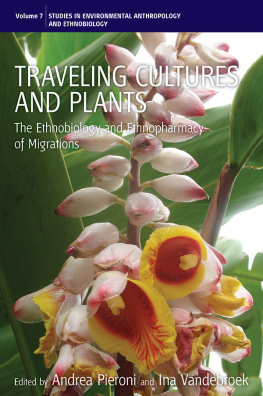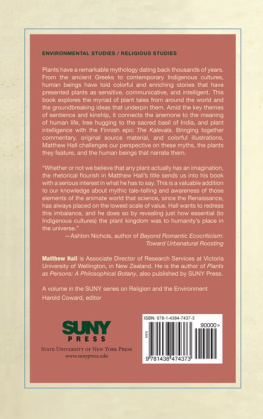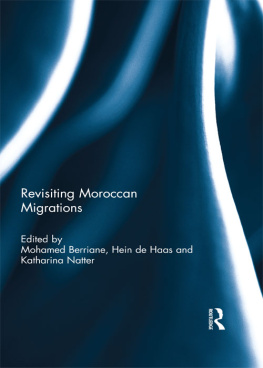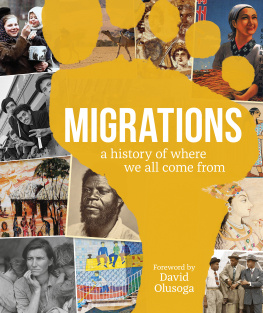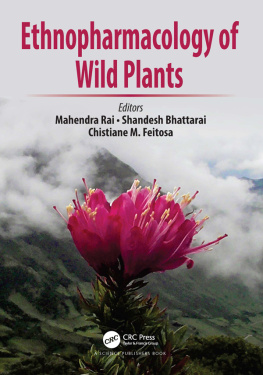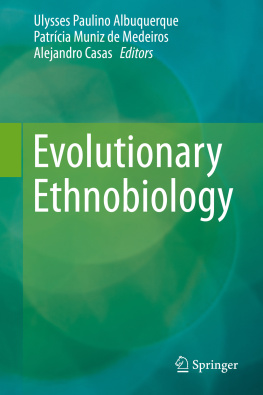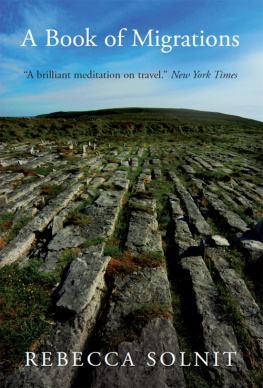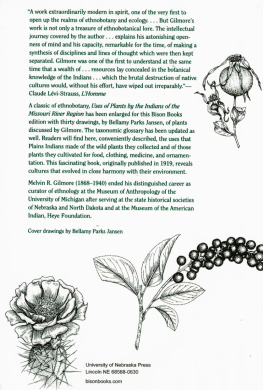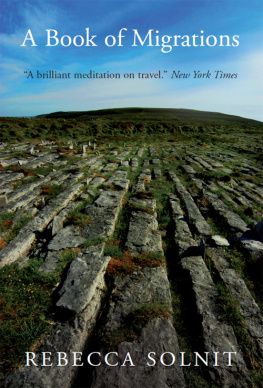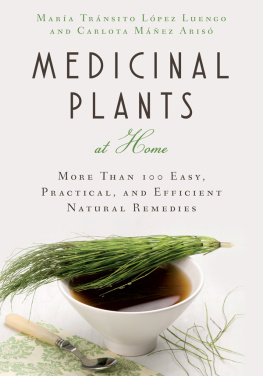Vandebroek Ina - Traveling cultures and plants: the ethnobiology and ethnopharmacy of human migrations
Here you can read online Vandebroek Ina - Traveling cultures and plants: the ethnobiology and ethnopharmacy of human migrations full text of the book (entire story) in english for free. Download pdf and epub, get meaning, cover and reviews about this ebook. City: New York, year: 2009, publisher: Berghahn Books, genre: Politics. Description of the work, (preface) as well as reviews are available. Best literature library LitArk.com created for fans of good reading and offers a wide selection of genres:
Romance novel
Science fiction
Adventure
Detective
Science
History
Home and family
Prose
Art
Politics
Computer
Non-fiction
Religion
Business
Children
Humor
Choose a favorite category and find really read worthwhile books. Enjoy immersion in the world of imagination, feel the emotions of the characters or learn something new for yourself, make an fascinating discovery.
- Book:Traveling cultures and plants: the ethnobiology and ethnopharmacy of human migrations
- Author:
- Publisher:Berghahn Books
- Genre:
- Year:2009
- City:New York
- Rating:5 / 5
- Favourites:Add to favourites
- Your mark:
- 100
- 1
- 2
- 3
- 4
- 5
Traveling cultures and plants: the ethnobiology and ethnopharmacy of human migrations: summary, description and annotation
We offer to read an annotation, description, summary or preface (depends on what the author of the book "Traveling cultures and plants: the ethnobiology and ethnopharmacy of human migrations" wrote himself). If you haven't found the necessary information about the book — write in the comments, we will try to find it.
Vandebroek Ina: author's other books
Who wrote Traveling cultures and plants: the ethnobiology and ethnopharmacy of human migrations? Find out the surname, the name of the author of the book and a list of all author's works by series.
Traveling cultures and plants: the ethnobiology and ethnopharmacy of human migrations — read online for free the complete book (whole text) full work
Below is the text of the book, divided by pages. System saving the place of the last page read, allows you to conveniently read the book "Traveling cultures and plants: the ethnobiology and ethnopharmacy of human migrations" online for free, without having to search again every time where you left off. Put a bookmark, and you can go to the page where you finished reading at any time.
Font size:
Interval:
Bookmark:
Chapter 1

Medicinal Plants and
Cultural Variation across
Dominican Rural, Urban, and
Transnational Landscapes
Andreana L. Ososki, Michael J. Balick,
and Douglas C. Daly
Introduction
Ethnobotanical knowledge evolves as it is exchanged, transferred, and appropriated by people adapting to new surroundings and changing environments (Lee et al. 2001; Voeks and Leony 2004). As people migrate between rural and urban environments, they exchange knowledge, cultural traditions, and medicinal plants. Fixed borders do not exist between rural, urban, and transnational groups, nor do they exist between laypeople and healers, as information is shared through various channels.
Medicinal plant knowledge is important for health care initiatives (Bodeker 1995; Bodeker and Kronenberg 2002) and conservation efforts (King 1996; Balick et al. 2002), yet our understanding of the distribution of plant knowledge within a community or across multiple communities is in its infancy (Campos and Ehringhaus 2003). Ethnobotanical studies tend to understate the variation of plant knowledge by reporting plant use information as homogeneous throughout a cultural group. Ethnobotanical knowledge is diverse and can differ markedly from one individual to another, as well as from one community to another, making it difficult to analyze. Studying cultural variation of ethnomedical knowledge gives insight into the distribution and transmission of plant use information in a community. These studies can help demonstrate the complexities and dynamics of medicinal plant knowledge and offer insight into cultural change. In addition, a description of these patterns provides a benchmark for future studies to evaluate erosion or acquisition of knowledge over time.
Dominican traditional medicine is not limited to the borders of the Dominican Republic, as New York City has a growing Dominican community that continues to maintain traditional healing practices (Balick et al. 2000; Reiff et al. 2003). When Dominicans immigrate to New York City, they continue to use traditional medical practices. Twenty-four percent of Dominicans surveyed in New York City emergency rooms in 1997 reported using complementary and alternative medicine (CAM) in the form of home remedies or traditional medicine for their presenting complaint (Allen et al. 2000).
In this chapter, we examine the differences and similarities of medicinal plant knowledge in the Dominican Republic and among Dominicans in New York City. Using ethnographic and ethnobotanical fieldwork, we highlight the richness of plant species and herbal therapies used specifically for women's health, the diversity of this knowledge across rural, urban, and transnational landscapes, and the processes affecting cultural variation.
Study Sites
Research was conducted in two provinces in the Dominican Republic and in New York City, the latter as part of an on-going project known as the Urban Ethnobotany Project, which began in 1996. Fieldwork in the Dominican Republic was conducted from September 2000 to August 2001.
New York City
New York City has the second largest Hispanic population and the largest Dominican population (an estimated 424,847 people) of any US city (US Census Bureau 2000). Dominican healers involved in the Urban Ethnobotany Project resided in Washington Heights, Inwood, and the Bronx.
Dominican Republic
The Dominican Republic (48,225 km2) occupies two-thirds of the island of Hispaniola, with Haiti occupying the remaining one-third. The population of the Dominican Republic is estimated to be slightly over 9 million (US Census Bureau 2005) with 70 percent of the population residing in urban centers. The ethnic origins of the Dominican population are 73 percent mulattos (defined as persons of mixed European and African ancestry), 16 percent of European descent, and 11 percent of African descent (Bolay 1997). The native language is Spanish and is blended with indigenous and African elements specific to the Dominican Republic (Cambeira 1997).
The study sites in the Dominican Republic were located in the provinces of La Vega and San Cristbal (). Both a rural community and an urban community were selected in each province. La Vega is located in the central region of the country known as the Cibao, and San Cristbal is located southwest of the capital, Santo Domingo. The study sites located in La Vega were Los Calabazos, a rural community, and the city of La Vega. Within the city, Proyecto Habitacional de San Miguel was selected as the study area. The study sites in the province of San Cristbal were La Colonia, a rural community, and Proyecto Hacienda Fundacin, a section of the city of San Cristbal. We will refer to the urban sites as San Cristbal and La Vega. The study sites were selected based on the following criteria: presence of a women's organization, rural and urban sites at comparable distances in both provinces, and agreement of the community to participate in the study.

Figure 1.1. Map of the Dominican Republic showing the four study sites: Los Calabazos, La Vega city (San Miguel), La Colonia, and San Cristbal city (Hacienda Fundacin)
Research Methods
Medicinal Plants and Dominicans in New York City
The Urban Ethnobotany Project has been working with Latino healers in New York City since 1996 to learn about their traditional healing practices for women's health conditions (Balick et al. 2000; Reiff et al. 2003; Fugh-Berman et al. 2004). The project has focused on the following health conditions: endometriosis (growth of endometrial tissue outside of the uterus); hot flashes (sudden brief sensations of heat often experienced during menopause); menorrhagia (excessive uterine bleeding); and uterine fibroids (benign connective tissue tumors). Most recently, this study has focused on herbal therapies for uterine fibroids and hot flashes.
Data collected from Dominican healers in New York City were based on multiple patient-healer consultations, with different patients previously diagnosed by a medical physician with the aforementioned health conditions. Following the consultations, both healers and patients were interviewed. Interviews with the healers provided additional insight into healing beliefs and practices (Reiff et al. 2003) and a more thorough understanding of medicinal plant recommendations for the patients (Balick et al. 2000). Accompanied by Dominican healers, we collected plant samples, which was a valuable and necessary component of these interviews. Fresh and dried plant samples were collected at local botnicas in New York City to verify their scientific names and to better understand how plants are selected, which parts are used, and how the plants are prepared into medicines.
Botnicas are shops that sell traditional remedies and function as herbal pharmacies providing fresh and dried herbs, mixtures, and tinctures, as well as religious and ritual items such as candles, oils, figurines of saints, and holy water (agua bendita) (Fisch 1968; Borello and Mathias 1977; Delgado and Santiago 1998). Voucher specimens, often plant fragments from botnicas, were prepared of all of the plants reported during the consultations and are stored at the herbarium of the New York Botanical Garden. In addition to traditional healers, shopkeepers and assistants, who handled the medicinal plants at botnicas, shared herbal therapies commonly prepared with Dominican plants.
Based on these initial interviews and plant collecting trips in New York City, we became familiar with common medicinal plants used and sold by Dominicans there. In addition, we conducted a comparative literature review to gather baseline data about Dominican plants used for women's health conditions, which further provided us with a working knowledge of Dominican plants, their uses, and their common names (Ososki et al. 2002). Through our literature review we found only limited discussion and minimal details provided on women's health categories suggesting the need for further investigation in this area, which led us to conduct research in the Dominican Republic and expand the number of health conditions studied to include menstruation, pregnancy, and menopause.
Next pageFont size:
Interval:
Bookmark:
Similar books «Traveling cultures and plants: the ethnobiology and ethnopharmacy of human migrations»
Look at similar books to Traveling cultures and plants: the ethnobiology and ethnopharmacy of human migrations. We have selected literature similar in name and meaning in the hope of providing readers with more options to find new, interesting, not yet read works.
Discussion, reviews of the book Traveling cultures and plants: the ethnobiology and ethnopharmacy of human migrations and just readers' own opinions. Leave your comments, write what you think about the work, its meaning or the main characters. Specify what exactly you liked and what you didn't like, and why you think so.

